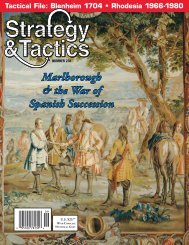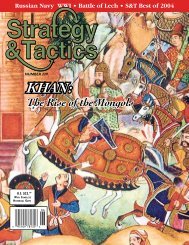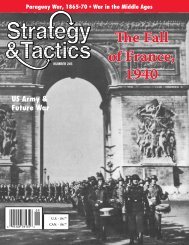COUNTERSTROKE AT SOLTSY - Strategy & Tactics Press
COUNTERSTROKE AT SOLTSY - Strategy & Tactics Press
COUNTERSTROKE AT SOLTSY - Strategy & Tactics Press
You also want an ePaper? Increase the reach of your titles
YUMPU automatically turns print PDFs into web optimized ePapers that Google loves.
War and Society<br />
The Treaty of Westphalia brought to an end the<br />
Thirty Years War (1618-48). That war had originally<br />
started as another round in what was becoming a seemingly<br />
endless series of religious conflicts in Europe,<br />
triggered by the rise of Protestantism in the early 16 th<br />
century. The issues Protestantism raised went beyond<br />
religion and included fundamental political disputes.<br />
Since the rise of the Carolingian Empire in the 8 th century<br />
AD, the European ideal was to form a united state<br />
ruling over the entire continent. The Holy Roman Empire<br />
was an attempt to bring about this universal state.<br />
The Holy Roman Empire, as wits frequently described<br />
it, was neither “holy,” nor “Roman,” nor much of an<br />
“empire.” Not since the Dark Ages had even the city<br />
of Rome been included within the empire’s boundaries<br />
and, in fact, the papacy frequently fought against various<br />
emperors, the latter coming from various German<br />
houses.<br />
By the 17 th century, the Holy Roman Empire was<br />
little more than a collection of states in central Europe,<br />
loosely organized around a fragmented Germany with<br />
the capital in Vienna and the throne in the hands of<br />
the Habsburg family. Challenging the empire, not<br />
merely militarily but ideologically, were the rising<br />
national states of Europe The protestant churches of<br />
Sweden and England, since they did not acknowledge<br />
the supremacy of the papacy in Rome, provided an<br />
ideological counterbalance to the centralizing and universal<br />
appeal of “empire.” And even Catholic France<br />
frequently put its national aspirations higher than any<br />
pan-Catholic or even Christian interests, frequently allying<br />
itself with the Moslem Ottoman Empire.<br />
All that came to a head with the Thirty Years War,<br />
which initially pitted Catholic Austria and Spain (representing<br />
the empire) against Protestant German states<br />
and then Denmark and Sweden. But the nature of<br />
the conflict changed with the intervention of France<br />
against the empire. French national interests demanded<br />
Europe not be consolidated under a single great<br />
empire. The war came to an end with the aforementioned<br />
Treaty of Westphalia. While the treaty did not<br />
end warfare in Europe, it did fundamentally change its<br />
nature.<br />
The Thirty Years War was fought with unprecedented<br />
disregard for the civilian populace, with pillaging<br />
and devastation a normal part of operations.<br />
Aside from the moral issues, the destruction of crops<br />
and cities undermined the civilian economies. That, in<br />
turn, undermined the power of the governments to collect<br />
taxes and maintain order. The European governments<br />
decided it was time to restrain their armies and<br />
minimize the destruction. It wasn’t simply a matter of<br />
altruism, but also of self-preservation. Out of control<br />
armies were as much a threat to the kings and princes<br />
as they were to the citizenry. For example, Albrecht<br />
Wallenstein, the imperial warlord of the Thirty Years<br />
War, had amassed more power than the Hapsburgs and<br />
might have set himself up as emperor were it not for<br />
his assassination in 1634<br />
There was also the growing professionalization of<br />
the armies. Up until the mid-17 th century, recruiting<br />
was a haphazard affair. Soldiers were drawn from mercenaries,<br />
quasi-professional regulars, and remnants of<br />
feudal levies. Countries such as Sweden showed that<br />
a regular military with a professional officer corps<br />
was the way of the future. A regular army had the advantages<br />
of superior discipline and training. Recruits<br />
needed to be exercised in the drills required to employ<br />
the complex tactics of the day. Officers were drawn<br />
from the nobility, and that had the added benefit of<br />
putting them to some good use.<br />
Politically, the states of Europe were becoming<br />
more centralized. Feudal relationships were disintegrating<br />
and being replaced by central government administrations<br />
with taxation and nation-wide laws. That<br />
meant governments could mobilize far more strength<br />
than they could in the past, and did not waste time and<br />
resources in civil war. All that was backed by new ideologies<br />
that justified centralized rule: the divine rights<br />
of kings as well as Hobbes’s Leviathan.<br />
With well disciplined armies and centralized states,<br />
the European governments had instruments with<br />
which they could conduct warfare as if it were a game<br />
of chess. And, not incidentally the army could be used<br />
to maintain the monarch’s power by suppressing any<br />
rebels.<br />
In a sense, what the Treaty of Westphalia recognized<br />
was that among European monarchs there was<br />
no issue worth mutual self-destruction. By limiting<br />
conflict to disputes over the balance of power all states<br />
could be assured of their continual existence. Yet the<br />
Age of Enlightenment was also an age of war—even<br />
if limited. But the wars were fought not to conquer<br />
entire countries or to establish a European-wide polity.<br />
For the most part, they were “civilized” affairs that<br />
resulted in the acquisition or loss of a border province<br />
or two.<br />
Balance of Power<br />
The central feature of both war and international<br />
politics in this era was the balance of power. Simply<br />
put, the balance ensured no one European state became<br />
strong enough to dominate the entire continent. Effectively,<br />
that meant the old ideal of empire was dead.<br />
Each state would keep its integrity and, while borders<br />
might fluctuate, only minor gains and losses of territory<br />
would be allowed. Even a monarch as powerful as<br />
Louis XIV of France (1643-1715) proved incapable of<br />
defeating the balance. In the War of the Spanish Succession<br />
(1701-14), his attempts to set a relative on the<br />
throne of Spain led to a European coalition marching<br />
against him. Ironically, what saved him in the end was<br />
strategy & tactics 21







